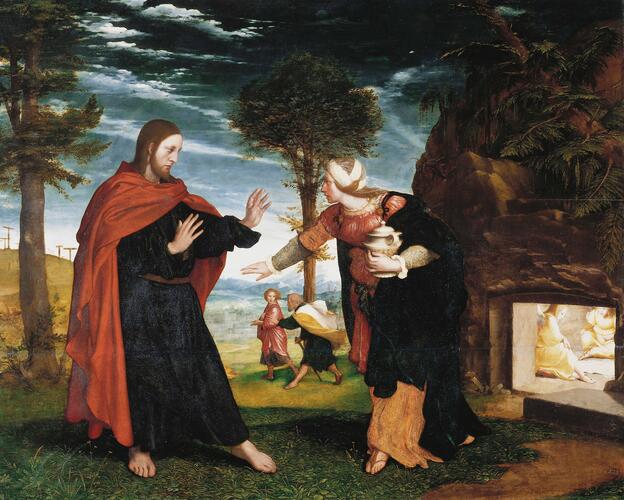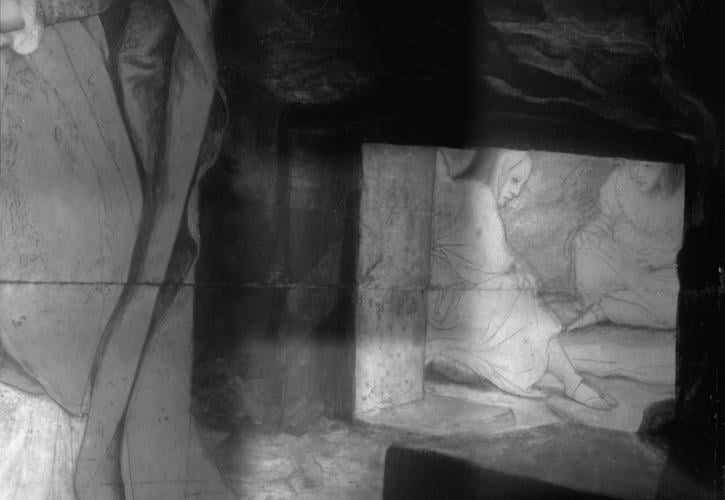-
1 of 253523 objects
'Noli Me Tangere' 1526-28
Oil on oak panel | 76.7 x 95.8 cm (support, canvas/panel/stretcher external) | RCIN 400001
-
When the diarist John Evelyn saw this painting in Charles II's Private Lodgings at Whitehall in 1680 he recorded that he 'never saw so much reverence & kind of Heavenly astonishment, expressed in Picture' . 'Noli me tangere' is the Latin for 'touch me not', the words spoken to Mary Magdalene by Christ after she discovers him risen from the tomb ('Touch me not; for I am not yet ascended to my Father' John 20: 17). Holbein's unusual depiction focuses on the moment when the mourning Magdalen, having found two angels in the empty place of Christ's body at the tomb, turns and encounters a man whom she takes to be a gardener.
The majority of Holbein's religious paintings were intended as large altarpieces. This is a smaller, more intimate narrative scene. Mary Magdalene pivots dramatically, her right hand outstretched as though to prevent collision with the man before her. Christ in turn holds out both arms to stop her progress, seemingly in an attempt to soothe her before the moment of recognition. The result is a graceful pas de deux. The colours of her dark cloak and red robe are reversed in the figure of Christ so that the two become negatives of one another. These colours and the poses of the principal figures are echoed by Saints Peter and John in the middle distance who are shown striding towards the city of Jerusalem in the distance in order to announce their discovery of the empty tomb. Light is crucial to the narrative. Silhouetted against the dawn sky on the left are numerous crosses on the hill of Calvary. Also lit and isolated at the centre of the scene are the hands of Christ and the Magdalen. The dawn light has yet to reach the inky darkness above the figures and while Christ's face is in full light, Mary's face is in half shadow, increasing the sense of confusion expressed in her eyes. A confusion, showing doubt and sadness which will soon be replaced by the clear dawn light and the certainty of the Resurrection. In the interior of the tomb, which radiates an ethereal light, are two seated angels, blanched by the strength of the light and one of the them gazes directly at us.
It seems likely that this work was painted between 1526 and 1528 during Holbein's first visit to England. It is painted on oak (which the artist did not use in Basel) and stylistically it conforms to Holbein's style at this date. An anonymous Noli me Tangere appears in the inventories of Henry VIII, but Holbein did not work directly for the King until his second visit to England. It is likely that the painting was in the collection of Henrietta Maria, the widow of Charles I, who ended her days in the convent of Colombes near Paris, and that it was collected for Charles II after her death in 1669. The ointment jar held by Mary has been compared with contemporary French earthenware (from Saint Porchaire, for example) but it appears closer to the wares produced in Antwerp at the time and there is no reason to doubt that it is an object of Holbein's own design.
Underdrawing, revealed by infra-red reflectography, and x-radiography show the care with which Holbein planned the work. He made several changes. One example is that in the x-ray one can see that Holbein originally intended that Christ and Mary Magdalene should face each other squarely across the centre of the picture. He then heightened and enlarged the position of Christ to give him more dominance over the startled Magdalene. Another is that originally the Apostles were running towards a wicket gate, with a wooded landscape behind. In the final painting the trees were made into the city of Jerusalem towards which Peter and John rush with no impediment of a gate to an enclosed garden. The trees have been identified: on the left an elm, centre a hawthorn and on the right a larch. The meticulously painted myriad of plants at the feet of Christ and Mary have also been identified and both trees and plants have been interpreted as reinforcing the story because of their associations with for example healing, spiritualism, majesty, death, the Crucifixion and the Resurrection.
This is the only religious painting by Holbein in the Royal Collection. In addition to the five miniatures and eighty drawings, there are seven painted portraits, all of them dating from Holbein's two stays in England.
Catalogue entry adapted from The Northern Renaissance. Dürer to Holbein, London 2011Provenance
Possibly to be identified with the paintings of this subjected recorded at Whitehall in 1542 (no 695) and in 1669 above the chimney in the Queen Henrietta Maria's cabinet next her bedchamber at the chateau of Colombes near Paris; first certainly recorded among the late King Charles II's pictures 'in the Queen Dowager's custody' at Whitehall in 1688 (no 686)
-
Creator(s)
Acquirer(s)
-
Medium and techniques
Oil on oak panel
Measurements
76.7 x 95.8 cm (support, canvas/panel/stretcher external)
94.9 cm (support, excluding additions)
93.1 x 111.9 x 5.0 cm (frame, external)
Category
Object type(s)
Other number(s)
Alternative title(s)
Mary at Our Lord's Sepulchre

